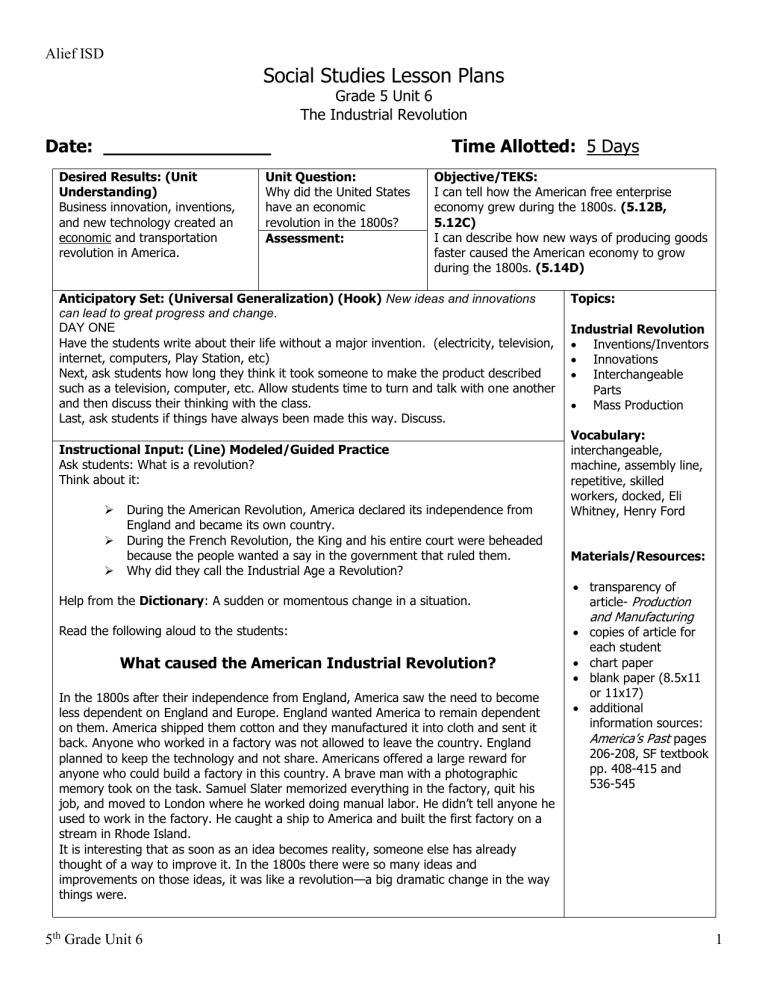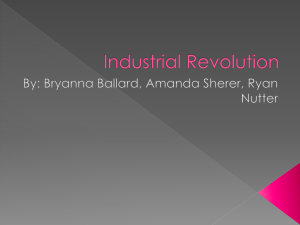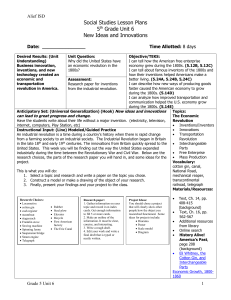Producing Goods Faster

Alief ISD
Social Studies Lesson Plans
Grade 5 Unit 6
The Industrial Revolution
Date: _______________ Time Allotted: 5 Days
Anticipatory Set: (Universal Generalization) (Hook)
New ideas and innovations can lead to great progress and change.
DAY ONE
Desired Results: (Unit
Understanding)
Business innovation, inventions, and new technology created an economic and transportation revolution in America.
Unit Question:
Why did the United States have an economic revolution in the 1800s?
Assessment:
Objective/TEKS:
I can tell how the American free enterprise economy grew during the 1800s. (5.12B,
5.12C)
I can describe how new ways of producing goods faster caused the American economy to grow during the 1800s. (5.14D)
Have the students write about their life without a major invention. (electricity, television, internet, computers, Play Station, etc)
Next, ask students how long they think it took someone to make the product described such as a television, computer, etc. Allow students time to turn and talk with one another and then discuss their thinking with the class.
Last, ask students if things have always been made this way. Discuss.
Topics:
Industrial Revolution
Inventions/Inventors
Innovations
Interchangeable
Parts
Mass Production
Vocabulary: interchangeable, machine, assembly line, repetitive, skilled workers, docked, Eli
Instructional Input: (Line) Modeled/Guided Practice
Ask students: What is a revolution?
Think about it:
During the American Revolution, America declared its independence from
England and became its own country.
During the French Revolution, the King and his entire court were beheaded because the people wanted a say in the government that ruled them.
Why did they call the Industrial Age a Revolution?
Help from the Dictionary: A sudden or momentous change in a situation.
Read the following aloud to the students:
What caused the American Industrial Revolution?
In the 1800s after their independence from England, America saw the need to become less dependent on England and Europe. England wanted America to remain dependent on them. America shipped them cotton and they manufactured it into cloth and sent it back. Anyone who worked in a factory was not allowed to leave the country. England planned to keep the technology and not share. Americans offered a large reward for anyone who could build a factory in this country. A brave man with a photographic memory took on the task. Samuel Slater memorized everything in the factory, quit his job, and moved to London where he worked doing manual labor. He didn’t tell anyone he used to work in the factory. He caught a ship to America and built the first factory on a stream in Rhode Island.
It is interesting that as soon as an idea becomes reality, someone else has already thought of a way to improve it. In the 1800s there were so many ideas and improvements on those ideas, it was like a revolution—a big dramatic change in the way things were.
Whitney, Henry Ford
Materials/Resources:
transparency of article- Production and Manufacturing
copies of article for each student
chart paper
blank paper (8.5x11 or 11x17)
additional information sources:
America’s Past pages
206-208, SF textbook pp. 408-415 and
536-545
5 th Grade Unit 6 1
Alief ISD
DAY TWO
Follow the steps for the Vocabulary Word Splash strategy. (attached)
The teacher may choose to preview vocabulary words with students or write words on chart paper with a description and/or symbol to support students’ understanding of the words.
* Optional: After introducing the words and definitions, place students into groups of 5 and assign each student one word from the Word Splash list and a large index card.
Provide time for students to copy the word and create their own definition and nonlinguistic representation. Allow students time to share with their vocabulary cards with their group.
Vocabulary Splash Words: interchangeable parts assembly line docked pay
Eli Whitney machine repetitive
Henry Ford skilled workers
Next, show students the article, Production and Manufacturing, on the overhead and provide a copy for each student to use.
Read the passage in a shared reading format. The teacher will stop occasionally to think aloud for students and to demonstrate use of the comprehension strategies that have been taught to date including the comprehension strategy that is the current focus strategy. (i.e. questioning, inferring, determining importance, etc.) The teacher may also choose to model additional strategies used when reading nonfiction text such as underlining important parts, taking notes in the margin, etc. and/or how to read twocolumn formatted text.
DAY THREE
Allow students the opportunity to reread the article (independently or with a partner) and take their own notes keeping in mind the strategies they are currently practicing.
* It is important to encourage students to reread nonfiction multiple times to gather information and gain deeper understanding of the content.
Ready, Set, Recall Strategy
Read and discuss the Power Point about Eli Whitney: Eli Whitney, the Cotton Gin, and
Interchangeable Parts
After students have had the opportunity to discuss the PPT and reread the article, provide each student with a blank piece of paper while collecting their copy of the article read. The student will fold their paper in half three times to create 8 squares.
Each student will write down as many things as they can remember from the article, one fact or thought, in each square. Selected information should focus on the unit understanding of how new technology created an economic revolution in
America. Provide students time to write initial recall items as well as time to think about strategies they used and comments they made during the reading which might aid in the recall of additional facts.
* Students do not have to fill in all squares of the paper. Students should be able to fill in two or more squares independently.
DAY FOUR
Once students have had plenty of opportunity for their individual recall, place students into groups of 3-4 to share what they each recalled from the article. Students are then
5 th Grade Unit 6 2
Alief ISD allowed to “borrow” ideas from others in their group to fill up their squares with recall information. Students should leave one square blank on their paper for the summary to be written later.
Modifications: Students only fold paper twice so that there are 4 squares or the teacher may choose to have students complete squares on the front and the back of the paper
(16 squares).
After students have completed their recall paper, each student will write a summary statement in the last square relating the information back to the unit understanding:
Business innovation, inventions, and new technology created an economic and transportation revolution in America.
Modification: Students may work with teammates to develop a summary statement, the teacher may model how to write a summary statement, or the teacher may choose to pull small groups to work with to write the summary statement based on the information from their recall.
Independent Practice: (Sinker)
DAY FIVE
Students will be given a blank piece of paper to fold in half. On the left side of the paper, students will illustrate life before the changes brought by Eli Whitney and Henry Ford’s inventions- interchangeable parts and the assembly line. On the right side of the paper, students will illustrate life after these changes occurred.
Students will write a paragraph describing the economic changes that occurred due to the inventions of these two people.
Modifications/Extensions: As stated throughout lesson.
Closure:
Focus students back to the unit understanding: Business innovation, inventions, and new technology created an economic and transportation revolution in America.
Unit Question: Why did the United States have an economic revolution in the 1800s?
How will you check for understanding?
- Do students have the background knowledge of the vocabulary words to complete the Word Splash activity?
- Are students using comprehension strategies appropriately as they reread the article,
Production and
Manufacturing.
- Are students able to recall at least two relevant facts from the article?
- Does the student generated ad demonstrate an understanding of the unit focus (understanding)?
- Are students able to answer the unit question?
Vocabulary Word Splash Definitions:
interchangeable: to put each in the place of the other
machine: a combination of parts that transmit forces, motion, and energy to do some desired work
assembly line: an arrangement of machines, equipment, and workers in which work passes from operation to operation in direct line until the product is assembled
repetitive: to make, do, or perform again
skilled workers: a person in a job that requires skill and training
docked: to take away a part of : make a deduction from
Student-friendly definitions located at http://www.wordcentral.com/home.html
5 th Grade Unit 6 3
Alief ISD
Vocabulary Word Splash
Objectives:
Assess prior knowledge
Provide motivation for reading
Set a clear purpose for reading
Decipher vocabulary
Allow for a variety of modes of learning
Steps:
1.
Select seven to ten social studies terms, people, or phrases from a unit of study.
Be sure to include not only similar words that will indicate the subject of the selection but also some of the words and phrases that seem contradictory to the others.
2.
Give each student a little time to think about what the terms, people or phrases have in common.
3.
Ask students to form small groups or three to five (or you can assign them to groups). In their groups, they should decide what the main category or topic is for the terms, people of phrases. They should also create a narrative or an explanation that will include all of the words of phrases.
4.
Ask each group to share their narrative or explanation. Ask students to list the common elements they heard and list these elements on the board or overhead.
5.
Once groups have shared their predictions, students will read the text to verify the accuracy of their narrative.
6.
After reading, small groups will gather again to discuss the accuracy of their prediction and then recreate their narrative on the right side of their writing paper.
7.
Ask each group to briefly share their rewritten narrative or explanation to the class.
Assessment:
1. Students, in small groups, are able to create a story using 90% of the words presented.
2. Students are able to identify and list at least one common element from every narrative presented.
Ready, Set, Recall
5 th Grade Unit 6 4
Alief ISD
Purpose in a Nutshell:
Quick, nonthreatening tool to use for review of content.
Have students /participants assume the responsibility for remembering, documenting and sharing material covered at prior meeting.
Has the potential to be used as an alternative to pop quiz or pre-test to find out what they know and what you need to cover to move them forward.
Theory Base
� Constructivism
- Connections must be personalized.
� Metacognition
- Talking about their thinking.
� Reflection
- How can they use it to improve?
Process/Procedure
Provide one slip or paper per person.
Independently, students list everything they can remember on their slip of paper about a given topic.
Individuals then team up in groups to combine and expand their lists; teacher announces a given time limit.
Have groups round robin, each group contributing one item at a time to the class generated list.
They are in until they run out and have to pass.
If they think of anything new, they can get back in.
Variation(s): From the master list have individuals pick out two that they have confidence that they could teach.
Groups could be asked to code entries on master list.
5 th Grade Unit 6 5
Alief ISD
Production and Manufacturing
Interchangeable Parts
In the early 1800’s, Eli Whitney came up with an idea that had a great impact on the way goods were produced.
Before his idea of interchangeable parts, skilled workers who made each item by hand from start to finish produced most goods. For example, a gunsmith worked long and hard on each gun he made. First the stock was made, then the barrel, and also the trigger. Each gun came out a little different, so if a part on a gun broke, the gunsmith would have to make a new part for that particular gun. This took a lot of time.
Whitney’s idea was to build a machine that made each separate part of the gun. That way, all the parts would be exactly alike. Each barrel would be the same length, and stocks would be the same size and shape. If something broke, it could be easily replaced.
Whitney’s idea of interchangeable parts made it possible to put together and repair things quickly. This idea began with guns but soon spread to other industries.
The Assembly Line
In 1913, Henry Ford introduced the idea of the assembly line. In his automobile factory, he had an assembly line where the frame of each car moved along on a
5 th Grade Unit 6 6
Alief ISD moving belt. Workers on each side of the belt added parts to the car. This allowed
Ford to make cars faster. He was then able to sell them for less than his competitors.
Scientific Management
Many of the factories in the early 20 th century operated under the philosophy of scientific management. Frederick Taylor, an American industrial engineer, made this theory popular. Taylor believed that workers should be hired to perform a small number of tasks, in a repetitive manner.
Scientific management discouraged workers from working more effectively and efficiently. The theory was that workers would definitely make mistakes, but inspectors would catch these at the end of the assembly line. Workers could then be docked for faulty workmanship. If a worker made too many mistakes, they could be fired.
Total Quality
William Deming is the person who made the Total Quality Philosophy popular. He felt that the method of scientific management made popular by Taylor was degrading to the human spirit. He thought that workers could be trained to conduct their own quality controls. Deming believed that if workers were trained and empowered to manage their own work processes, the quality of their output would increase. If workers could do this, then the inspectors at the end of the line would be unnecessary. Therefore, total quality would lower manufacturing costs.
5 th Grade Unit 6 7







